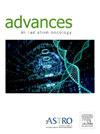外束放疗和近距离放疗对宫颈癌确诊患者循环髓源性抑制细胞群的影响。
IF 2.7
Q3 ONCOLOGY
引用次数: 0
摘要
目的:骨髓源性抑制细胞(MDSCs)的免疫抑制功能与癌症免疫应答的调节有关,并与不良预后有关。已知放射治疗可以改变肿瘤内的免疫细胞群;然而,这是否会导致免疫抑制MDSC群体的招募尚不清楚。在这里,我们评估了循环MDSC人群在接受标准顺铂放化疗(CRT)治疗局部浸润性宫颈癌患者中的反应。方法与材料:纳入新诊断的treatment-naïve局部晚期宫颈癌患者。分别在CRT开始前(T0)、外束放射治疗后(T1)和高剂量率近距离放射治疗后(T2)采集患者血样。对每个时间点的样本进行处理,并使用流式细胞术确定MDSC亚群的患病率。使用活/死cd11b +CD33+HLA-DR染色鉴定MDSC群体。MDSC亚群进一步细分为粒细胞(g-, CD15+CD14-),单核细胞(m-, CD15-CD14+)或早期mdscs (e-, CD15-CD14-)。结果:在我们的研究中,大多数患者是患有人乳头瘤病毒相关的宫颈鳞状细胞癌的白人非吸烟者。我们发现,在开始治疗时,晚期疾病患者的MDSC频率有增加的趋势。MDSCs对CRT的反应增加,近距离治疗后达到峰值(T2)。特别是,g-MDSC子集相对于基线增加了6.44倍。MDSC扩张与治疗反应之间没有相关性。结论:我们的研究证实了其他报道,宫颈癌患者循环MDSCs对CRT的反应增加,并且与更晚期的阶段相关。此外,我们表明MDSC扩展是由g-MDSC子集驱动的。我们没有看到MDSC扩张与治疗反应之间的任何相关性,尽管这可能是因为本研究的样本量有限。本文章由计算机程序翻译,如有差异,请以英文原文为准。
Effect of External Beam Radiation Therapy and Brachytherapy on Circulating Myeloid-Derived Suppressor Cell Populations in Patients Treated Definitively for Cervical Cancer
Purpose
The immunosuppressive function of myeloid-derived suppressor cells (MDSCs) has been implicated in the regulation of immune responses against cancer and is associated with poor prognosis. Radiation treatment is known to alter immune cell populations within the tumor; however, whether this results in the recruitment of immunosuppressive MDSC populations is not well understood. Here we evaluate the response of circulating MDSC populations in patients treated per standard-of-care cisplatin chemoradiation therapy (CRT) for locally invasive cervical cancer.
Methods and Materials
Newly diagnosed, treatment-naïve patients with locally advanced cervical cancer were enrolled. Blood samples were collected from patients prior to starting CRT (T0), after external beam radiation therapy (T1), and after high-dose-rate brachytherapy (T2). Samples from each time point were processed, and the prevalence of MDSC subsets was determined using flow cytometry. MDSC populations were identified using Live/Dead-CD11b+CD33+HLA-DR- staining. MDSC subsets were further subdivided into granulocytic (g-, CD15+CD14-), monocytic (m-, CD15-CD14+), or early-MDSCs (e-, CD15-CD14-).
Results
Most patients in our study were Caucasian nonsmokers with human papillomavirus-associated squamous cell carcinoma of the cervix. We saw a trend for increased MDSC frequency in patients with more advanced-stage disease at the time of initiating treatment. MDSCs increase in response to CRT and peak after brachytherapy (T2). In particular, the g-MDSC subset increases by 6.44 times relative to the baseline. There was no correlation between MDSC expansion and response to therapy.
Conclusion
Our study confirms other reports that circulating MDSCs in patients with cervical cancer increase in response to CRT and are associated with more advanced stages. Additionally, we show that MDSC expansion is driven by the g-MDSC subset. We did not see any correlation between MDSC expansion and treatment response, though this may be because of the limited sample size for this study.
求助全文
通过发布文献求助,成功后即可免费获取论文全文。
去求助
来源期刊

Advances in Radiation Oncology
Medicine-Radiology, Nuclear Medicine and Imaging
CiteScore
4.60
自引率
4.30%
发文量
208
审稿时长
98 days
期刊介绍:
The purpose of Advances is to provide information for clinicians who use radiation therapy by publishing: Clinical trial reports and reanalyses. Basic science original reports. Manuscripts examining health services research, comparative and cost effectiveness research, and systematic reviews. Case reports documenting unusual problems and solutions. High quality multi and single institutional series, as well as other novel retrospective hypothesis generating series. Timely critical reviews on important topics in radiation oncology, such as side effects. Articles reporting the natural history of disease and patterns of failure, particularly as they relate to treatment volume delineation. Articles on safety and quality in radiation therapy. Essays on clinical experience. Articles on practice transformation in radiation oncology, in particular: Aspects of health policy that may impact the future practice of radiation oncology. How information technology, such as data analytics and systems innovations, will change radiation oncology practice. Articles on imaging as they relate to radiation therapy treatment.
 求助内容:
求助内容: 应助结果提醒方式:
应助结果提醒方式:


